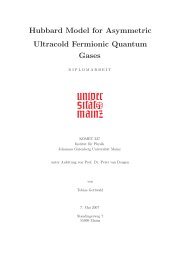5 Hirsch-Fye quantum Monte Carlo method for ... - komet 337
5 Hirsch-Fye quantum Monte Carlo method for ... - komet 337
5 Hirsch-Fye quantum Monte Carlo method for ... - komet 337
You also want an ePaper? Increase the reach of your titles
YUMPU automatically turns print PDFs into web optimized ePapers that Google loves.
<strong>Hirsch</strong>-<strong>Fye</strong> QMC 5.23<br />
Note the convergence factoreiωnη which is essential in order to get the correct result. Obviously,<br />
such a term is difficult to handle numerically; in practice, η may be replaced, e.g., by the time<br />
discretization parameter ∆τ, which also determines the cutoff frequency in the infinite sum.<br />
This approximation can be avoided by evaluating the noninteracting part separately. For the<br />
kinetic energy, this implies<br />
Ekin = lim<br />
η→0 +2T<br />
∞�<br />
e iωnη<br />
� ∞<br />
1<br />
dǫǫρ(ǫ)<br />
(43)<br />
iωn −ǫ+µ−Σ(iωn)<br />
� ∞<br />
= 2<br />
−∞<br />
� ∞<br />
≈ 2<br />
−∞<br />
n=−∞<br />
−∞<br />
ǫρ(ǫ)<br />
dǫ<br />
eβ(ǫ−µ) +1 +2T<br />
ǫρ(ǫ)<br />
dǫ<br />
eβ(ǫ−µ) +1 +2T<br />
∞�<br />
n=−∞<br />
L/2 �<br />
� ∞<br />
n=−L/2+1<br />
dǫ ǫρ(ǫ)<br />
−∞<br />
� Gǫ(iωn)−G 0 ǫ<br />
(iωn) �<br />
(44)<br />
� ∞<br />
dǫ ǫρ(ǫ) � Gǫ(iωn)−G 0 ǫ(iωn) � , (45)<br />
where we have assumed the paramagnetic case. Here, the interacting and noninteracting “momentumdependent”<br />
Green functions read<br />
Gǫ(iωn) =<br />
−∞<br />
1<br />
iωn −ǫ+µ−Σ(iωn) ; G0 ǫ (iωn) =<br />
1<br />
. (46)<br />
iωn −ǫ+µ<br />
In (45), the terms in the Matsubara sum fall off at least as1/ω 2 , which makes it well-defined also<br />
without convergence factor. At the same time, the truncation error is reduced significantly. The<br />
complementary ingredient to the energy is the double occupancyD withE = Ekin+UD. In the<br />
context of QMC calculations, this observable is best calculated directly from Wick’s theorem<br />
(i.e. as 〈ni↑ni↓〉 or the corresponding expression in Grassmann variables) when sampling over<br />
the auxiliary field. The overall behavior of D and E in the Hubbard model can be read off (<strong>for</strong><br />
T = 0.1) from the middle and lower parts of Fig. 13, respectively. For small U, the kinetic<br />
energy increases quadratically while D and, consequently, Epot and E increase linearly. The<br />
potential energy reaches a maximum below U = 3. A region of strong curvature of D, Epot,<br />
and Ekin near U = 4.6 gives a rough indication of the metal-insulator crossover. The total<br />
energyE, however, hardly shows any anomalies at this scale. Note also that the solutions <strong>for</strong>D<br />
and E are quite close to the results of plain zero-temperature second-order perturbation theory.<br />
The agreement actually becomes better <strong>for</strong> low-temperature QMC data, extrapolated to T → 0<br />
(not shown). The offset of the curves <strong>for</strong> E gives (<strong>for</strong> not too large U) an indication of the<br />
specific heatcV = dE/dT which is linear within the Fermi-liquid phase and is, in general, best<br />
evaluated by fitting the temperature dependence ofE. 18<br />
Susceptibilities<br />
The direct evaluation of the compressibility (as of most other susceptibilities) is numerically<br />
costly since it requires the QMC computation of 2-particle vertex functions. The <strong>for</strong>malism is<br />
omitted here; it can be found, e.g., in [1, 46].<br />
18 In Fermi liquid phases, the linear coefficient γ of the specific heat may also be obtained via the quasiparticle<br />
weightZ (extrapolated toT = 0).













